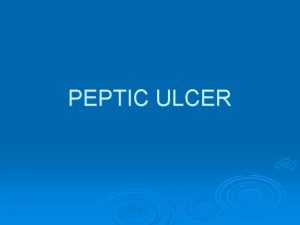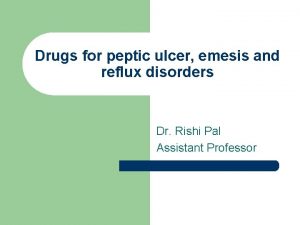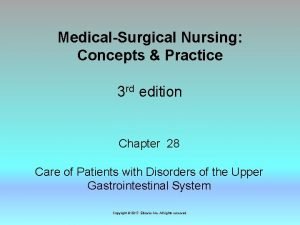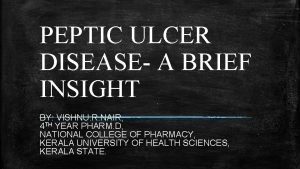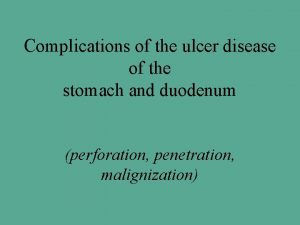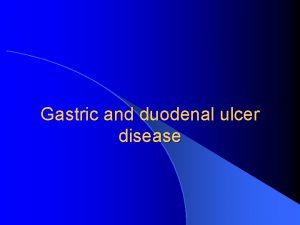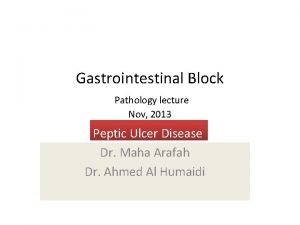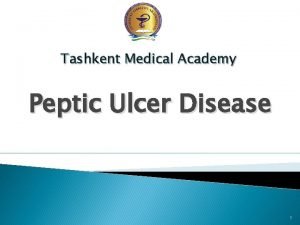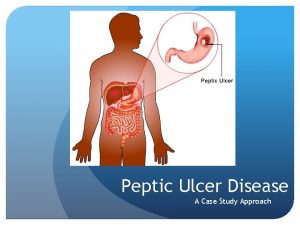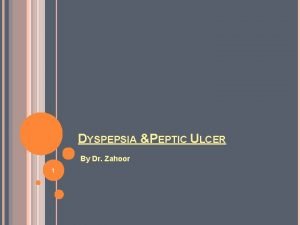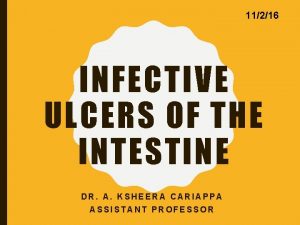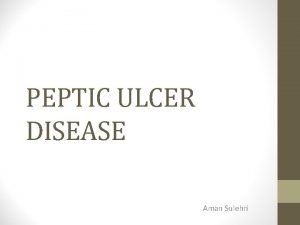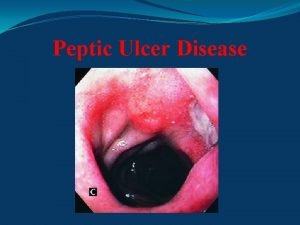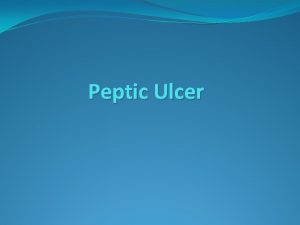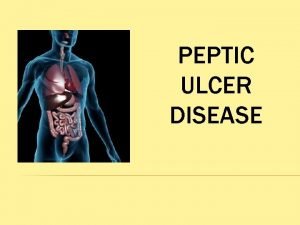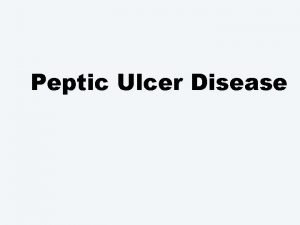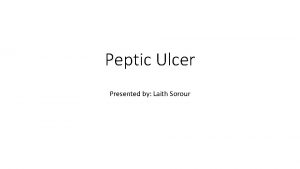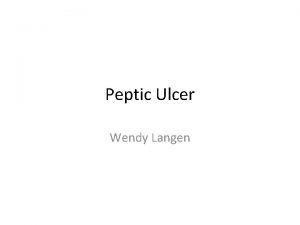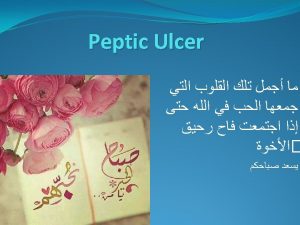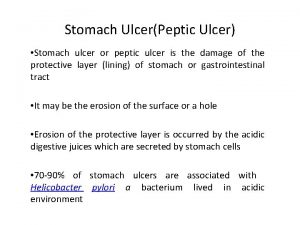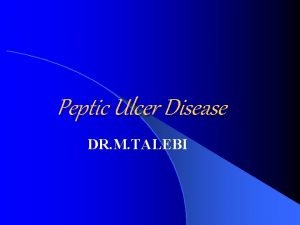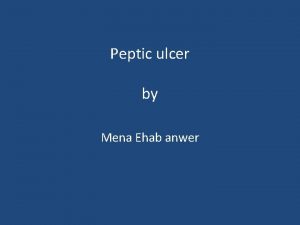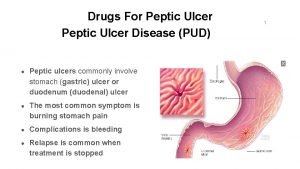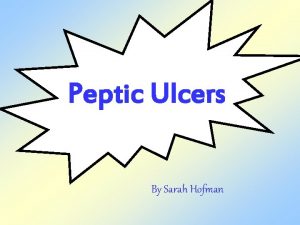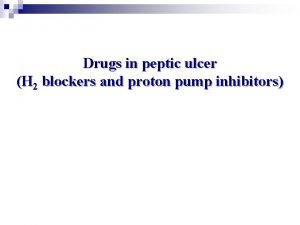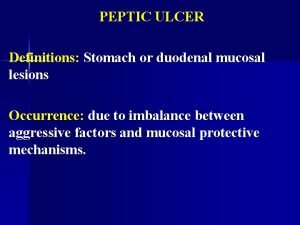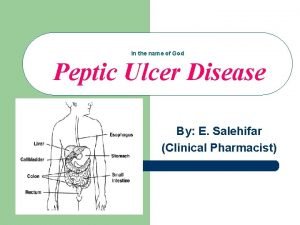Peptic Ulcer What is peptic ulcer A peptic


















- Slides: 18

Peptic Ulcer



What is peptic ulcer? �A peptic ulcer is an erosion of the mucosal lining of the stomach or duodenum. �Peptic ulcer disease (PUD) occurs when the mucosa is eroded to the point at which the epithelium is exposed to gastric acid and pepsin. �There are : �gastric ulcers, �duodenal ulcers �Esophageal ulcer, and � stress ulcers (these occur after major stress or trauma).

Causes of peptic ulcers �Helicobacter pylori infection (80 -95%) �Nonsteroidal anti-inflammatory drug (NSAID) use. �Severe stress (surgery, trauma, ICU) �Injury or death of mucosa producing cells �Hypersecretory states; hypercalcemia Genetics, blood group O


Diagnostic Procedures and Nursing Interventions �Helicobacter pylori testing: �Gastric samples are collected via an endoscopy to test for Helicobacter pylori. Several medications can interfere with testing for Helicobacter pylori (false negatives). �Urea breath testing is when the client exhales into a collection container (baseline), drinks carbon-enriched urea solution (13 C urea and citric acid), and is asked to exhale once again into a collection container. The client should take nothing by mouth prior to the test. If Helicobacter pylori is present, the solution will break down and CO 2 will be released. Ig. G serologic testing documents the presence of Helicobacter pylori based on antibody assays.

Diagnostic Procedures and Nursing Interventions �Stool sample tests for the presence of the Helicobacter pylori antigen. �Esophagogastroduodenoscopy (EGD) is the most definitive for diagnosis of peptic ulcers and may be repeated to evaluate treatment effectiveness. �Nsg responsibilities ? ? ? ? �Stool sample for occult blood (risk of PUD).



Assessment �Monitor for signs and symptoms of a peptic ulcer. �Dyspepsia – heartburn, bloating, and nausea. May be perceived as uncomfortable fullness or hunger. �Pain Gastric ulcer Duodenal ulcer 30 to 60 min after a meal 1. 5 to 3 hr after a meal Rarely occurs at night Often occurs at nigh Pain worsens with food ingestion Pain relieved by food ingestion



Assessment �Assess/monitor the client for: �Orthostatic changes in vital signs (20 mm Hg drop in systolic, 10 mm Hg drop in diastolic, and/or tachycardia; these findings are suggestive of gastrointestinal bleeding). �Nursing Diagnoses �Acute pain or chronic pain �Risk for deficient fluid volume �Disturbed sleep pattern � Anxiety related to coping with an acute disease � Imbalanced nutrition related to changes in diet �Deficient knowledge about preventing symptoms and managing the condition


Nursing Interventions �Administer prescribed medications. �Most commonly used is “triple therapy. ” This includes: �Bismuth or a Hyposecretory medication (proton pump inhibitors, histamine 2 antagonists, and prostaglandin analogues). �Two antibiotics to combat Helicobacter pylori: metronidazole (Flagyl) along tetracycline/ clarithromycin / amoxicillin. �Antacids are given 1 to 3 hr after meals to neutralize gastric acid, which occurs with food ingestion and at bedtime. Give 1 hr apart from other medications Sucralfate (Carafate) is given 1 hr before meals and at bedtime. Protects healing ulcers. Monitor for side effects of constipation.

Nursing Interventions �Assist the client with understanding/compliance with recommended dietary changes: �Avoiding/limiting substances that increase gastric acid secretion (caffeine, alcohol, and tobacco). �Avoiding foods that cause discomfort. �Smaller meals.

Complications and Nursing Implications �The nurse should perform periodic assessments of the client’s pain and vital signs (perforation or bleeding 0 �Perforation is severe epigastric pain spreading across the abdomen. The abdomen is rigid, board-like, hyperactive to diminished bowel sounds, and has rebound tenderness. �Perforation is a surgical emergency. �Gastrointestinal bleeding (? ? ? ? ? ) �The nurse should report findings, prepare the client for endoscopic or surgical intervention, replace fluid and blood losses, insert nasogastric tube, provide saline lavages, and maintain the client’s blood pressure. �Cancer
 Peptic ulcer diseas
Peptic ulcer diseas Peptic ulcers causes
Peptic ulcers causes What is emetics
What is emetics Pud triple therapy
Pud triple therapy Acholorhydria
Acholorhydria Patient counselling for peptic ulcer disease
Patient counselling for peptic ulcer disease Stages of peptic ulcer perforation
Stages of peptic ulcer perforation Polya gastrectomy vs billroth 2
Polya gastrectomy vs billroth 2 Peptic ulcer disease
Peptic ulcer disease Pathophysiology of peptic ulcer
Pathophysiology of peptic ulcer Stomach ulcer
Stomach ulcer Peptic ulcer case study
Peptic ulcer case study Triple therapy for peptic ulcer disease
Triple therapy for peptic ulcer disease Peptic ulcer disease
Peptic ulcer disease Peptic ulcer anatomy and physiology
Peptic ulcer anatomy and physiology Gasrectomy
Gasrectomy Longitudinal ulcers in typhoid
Longitudinal ulcers in typhoid Classification of ulcer
Classification of ulcer Stomach ulcer diet menu
Stomach ulcer diet menu

